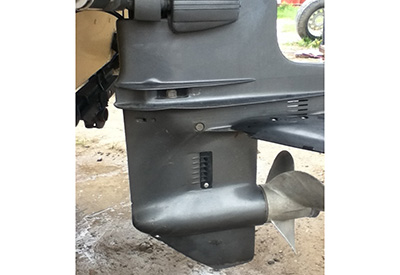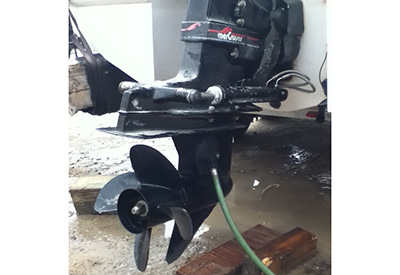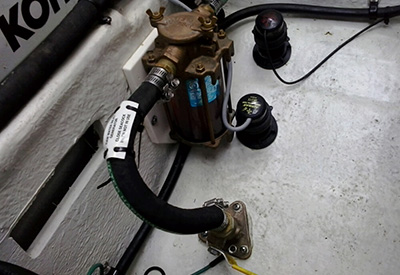Ask Andrew: Dealing with overheating – keeping cool on the water

June 14, 2018
Modern marine engines run at very high temperatures and rely on a few methods to keep their temperatures within an acceptable range (somewhere between 120 and 180 degrees Fahrenheit).
The Open Cooling system is by far the most common –and is common to both power and sail boats. It is relatively easily understood, and can be serviced by the average boater. Closed cooling systems work on different principles – more like an automotive cooling system – and we’ll cover these in a future article.
To describe an open cooling system simply: lake or sea water is used to keep the engine cool. Water is sucked up into the engine by a water pump. As the temperature of the engine increases, a thermostat (controlled by heat) opens, allowing the cooling water to be pushed through the engine’s passageways, and then pumped overboard with the engine exhaust.
I divide open cooling systems into three main types:
Outboard type
An outboard Leg – showing the water pick-up (in black)
Water is drawn into the engine through the leg of the outboard motor (which is immersed in lake water). Inside the leg of the outboard is a water pump with an impeller – a rubber device that acts like a waterwheel to both draw and push water into the engine at the top of the outboard. The seawater then runs through the engine, controlled by a thermostat, and once used, is spit out through a tell-tale or pitot tube.
 Stern Drive type:
Stern Drive type:
A stern drive unit, with hose and fitting attached to allow the engine to be run while ashore, still getting the water it needs to keep cool
Similar to the outboard type, a stern drive draws seawater through the drive, and into the engine. A water pump is driven by a spinning rubber impeller, which draws and pushes water into the engine. A thermostat directs the water’s flow, and it is helps through the engine by a second pump, driven by belts, called a circulation pump. Once used, water runs through tubes and forced out of stern drive with the engine exhaust. Some stern drives have a water-pump in the stern drive unit, others have a water pump installed on the engine.
 Seacock type
Seacock type
A through-hull fitting, seacock and strainer arrangement – draws in seawater and filters it before running through the engine.
Water is allowed entry into the boat through a through-hull and seacock arrangement (with a valve to open/close the seacock), and pumped into the engine via a water pump and impeller. Water is allowed to flow through the engine, guided by a thermostat, and flows out through the muffler and exhaust pipe
Each of these types use the same basic elements:
An impeller – a rubber device that acts like a water wheel
A thermostat – which opens and closes to restrict or allow water flow
Hoses – which allow the water to move from place to place
Drains – to allow water to be drained from the engine for prolonged or seasonal storage.
Engines overheat for a number of reasons. Here are some of the most common:
The intake is not immersed in water: The drive is trimmed up to far, the outboard leg is out of the water, or the seacock/through-hull is closed. The temperature gauge will rise quite quickly, and water won’t be seen running out with the exhaust. The thermostat housing will be hot to the touch
The water pump isn’t pumping water – typically caused by a damaged impeller.
The Thermostat isn’t opening or closing – Water runs in and out of the engine, but doesn’t cool the engine down
What if the engine does overheat? What should I check for?
- Check to make sure that water is coming into the engine. The easiest way to see this is to check at the exhaust to make sure that water is coming out. If water is coming out, water must be getting in.
- Check to see if water is getting to the thermostat. The thermostat housing has a number of houses on it – the hoses and the housing itself should be cool to the touch. If they are hot, chances are that the impeller is not drawing/pumping water properly
- Check the temperature of the engine and if it continues to rise, or stays at one level. If it maintains, or moves up/down, the thermostat is doing it’s job by opening and closing. If the temperature continues to rise, despite water coming into the housing, and out through the exhaust, then the thermostat may require replacement.
- Check for leaks or rips/tears in hoses, or cracks in the engine where water leaks when the engine is running. Hoses may need replacing, or plugs/drains replaced
Regular maintenance of the cooling system is important. Impellers should be inspected and changed at least every two years. Each time the boat is turned on, water flowing out through the exhaust should be visually checked.
Winter maintenance is critical – before temperatures drop below the freezing mark in the fall, the engine should be ‘winterized’ – this is the collective term for: draining water from the engine, by opening drain plugs, then running antifreeze through the engine from the point of water entry, through the engine, and out through the exhaust. The antifreeze displaces the water that was in the engine – water, as it freezes, expands. When it expands inside small internal passages, it can crack the surrounding metal, leading to costly repairs!
Safe boating – stay cool!
 Andrew McDonald is the owner of Lakeside Marine Services – a boat repair/maintenance firm based in Toronto. Andrew has worked in the marine industry for 12 years and is a graduate of the Georgian College ‘Mechanical Techniques – Marine Engine Mechanic’ program.
Andrew McDonald is the owner of Lakeside Marine Services – a boat repair/maintenance firm based in Toronto. Andrew has worked in the marine industry for 12 years and is a graduate of the Georgian College ‘Mechanical Techniques – Marine Engine Mechanic’ program.
Questions or comments for Andrew? Email him directly via: askandrew@lakesidemarineservices.ca




























